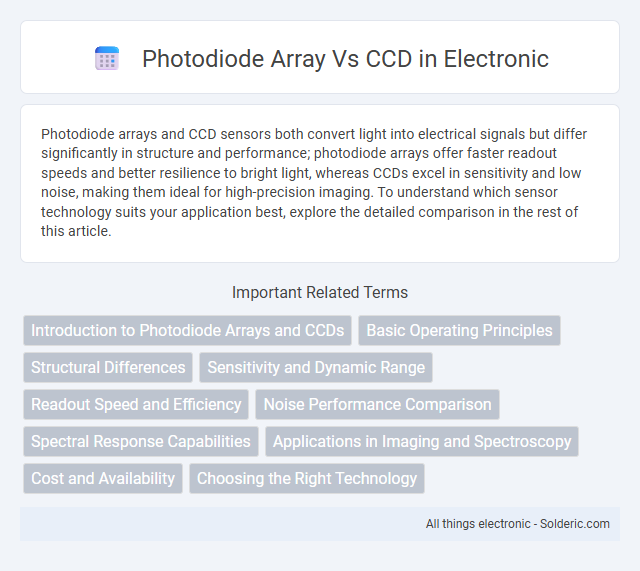Photodiode arrays and CCD sensors both convert light into electrical signals but differ significantly in structure and performance; photodiode arrays offer faster readout speeds and better resilience to bright light, whereas CCDs excel in sensitivity and low noise, making them ideal for high-precision imaging. To understand which sensor technology suits your application best, explore the detailed comparison in the rest of this article.
Comparison Table
| Feature | Photodiode Array (PDA) | Charge-Coupled Device (CCD) |
|---|---|---|
| Technology | Array of photodiodes converting light to current | Array of pixels storing charge, shifted and read sequentially |
| Sensitivity | Moderate sensitivity with fast response | High sensitivity with low noise performance |
| Speed | High-speed data acquisition | Slower readout due to charge transfer |
| Resolution | Typically lower pixel count | Higher pixel density and resolution |
| Dynamic Range | Limited dynamic range | Wide dynamic range |
| Cost | Lower cost and simpler design | Higher cost with complex electronics |
| Applications | Fast spectroscopy, industrial process monitoring | High-precision imaging, astronomy, microscopy |
Introduction to Photodiode Arrays and CCDs
Photodiode arrays and charge-coupled devices (CCDs) are essential semiconductor sensors used for converting light into electrical signals in imaging and spectroscopic applications. Photodiode arrays consist of multiple photodiodes arranged in a linear or two-dimensional configuration, allowing rapid detection of light intensity with high sensitivity and fast response times. CCDs store and transfer charge across the chip to create high-resolution images with low noise, making them ideal for precise imaging tasks where you require accurate light measurement and image quality.
Basic Operating Principles
Photodiode arrays convert light into electrical signals using multiple photodiodes arranged in a linear or two-dimensional array, where each photodiode generates current proportional to the incident light intensity. Charge-coupled devices (CCDs) store and transfer charge packets generated by light exposure across the chip, enabling high sensitivity and low noise image capture through charge shifting and readout processes. Understanding these basic operating principles helps you select the appropriate sensor for your application, balancing speed and image quality requirements.
Structural Differences
Photodiode arrays (PDAs) consist of linear or two-dimensional arrays of individual photodiodes directly converting light into electrical signals, each diode operating independently without charge transfer between elements. Charge-coupled devices (CCDs) feature a matrix of photosensitive elements where accumulated charges are shifted sequentially through the array via clocked transfer, enabling precise charge transport and low noise imaging. The structural distinction lies in PDAs' direct detection at each photodiode compared to CCDs' charge storage and transfer architecture, impacting readout methods and sensor sensitivity.
Sensitivity and Dynamic Range
Photodiode arrays offer higher sensitivity due to their direct photon-to-electron conversion, making them ideal for low-light detection, while CCDs provide a wider dynamic range by efficiently capturing both bright and dark regions in an image. Your choice depends on whether precise sensitivity for faint signals or a broader dynamic range for varied light conditions is more critical. Photodiode arrays excel in fast response times, whereas CCDs maintain image quality across a spectrum of intensities.
Readout Speed and Efficiency
Photodiode arrays offer significantly faster readout speeds compared to CCD sensors due to their parallel readout architecture, enabling rapid data acquisition critical for high-speed applications. CCDs, while generally providing higher image quality and lower noise, rely on serial charge transfer processes that reduce overall efficiency in high frame rate scenarios. Your choice between photodiode arrays and CCDs should consider the trade-off between readout speed and efficiency based on the specific demands of your imaging application.
Noise Performance Comparison
Photodiode arrays typically exhibit lower noise levels due to their direct charge-to-voltage conversion, enhancing signal clarity in low-light conditions. CCD sensors often experience higher readout noise resulting from charge transfer processes, which can degrade image quality especially in long exposures. Your choice depends on specific application needs, with photodiode arrays favoring noise-sensitive environments and CCDs excelling in uniformity and dynamic range.
Spectral Response Capabilities
Photodiode arrays offer high spectral response capabilities with fast detection across a broad wavelength range, typically from ultraviolet to near-infrared, making them suitable for real-time applications. CCD sensors provide superior spectral sensitivity and low noise performance, especially in visible to near-infrared regions, supporting high-resolution imaging and precise spectrometry. Your choice depends on whether you prioritize speed and wavelength range (photodiode arrays) or higher sensitivity and image quality (CCD).
Applications in Imaging and Spectroscopy
Photodiode arrays (PDAs) excel in real-time spectral analysis and chemical sensing due to their high-speed response and compact size, making them ideal for portable spectroscopy devices. Charge-coupled devices (CCDs) offer superior sensitivity and spatial resolution, which benefits applications in astronomical imaging, high-precision microscopy, and low-light imaging in spectroscopy. While PDAs enable fast spectral acquisition in industrial quality control, CCDs facilitate detailed two-dimensional imaging and spectral mapping in scientific research.
Cost and Availability
Photodiode arrays generally offer lower cost due to simpler manufacturing processes and widespread availability as standard semiconductor components. CCD sensors tend to be more expensive because of intricate fabrication and higher demand in specialized imaging applications. Both photodiode arrays and CCDs are commercially accessible, but photodiode arrays dominate cost-sensitive markets such as industrial sensing and spectroscopy.
Choosing the Right Technology
Photodiode arrays excel in high-speed scanning and simple, cost-effective applications due to their direct digital output and high sensitivity to visible light. Charge-coupled devices (CCD) offer superior image quality with higher resolution and better low-light performance, making them ideal for detailed imaging and scientific measurements. Selecting between photodiode arrays and CCDs depends on specific requirements such as speed, resolution, sensitivity, and budget constraints.
Photodiode array vs CCD Infographic

 solderic.com
solderic.com